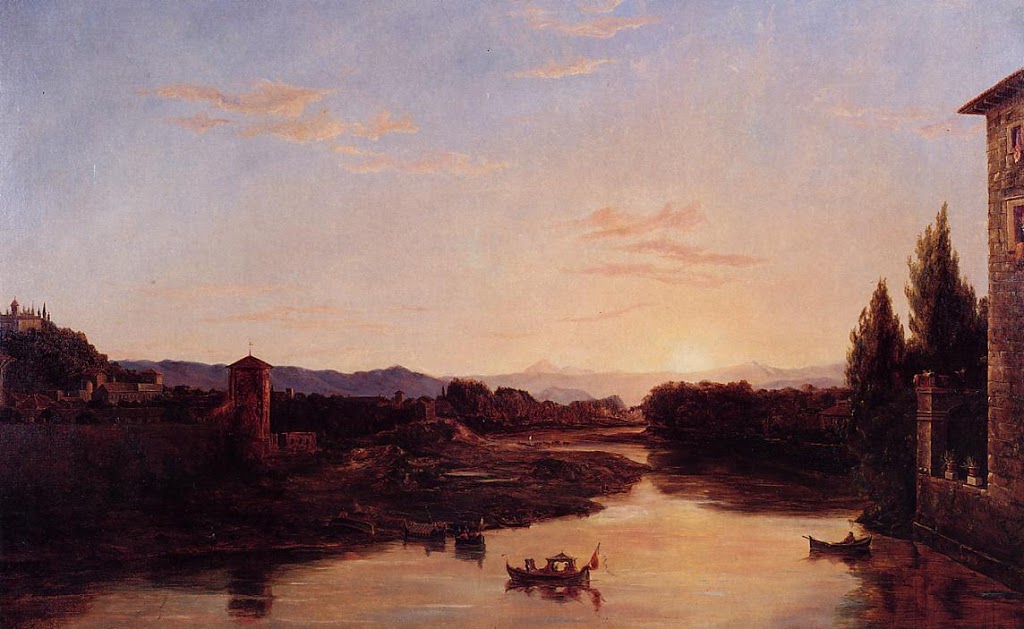Forty paintings from the Hudson River School of painting glow in the Shenandoah Valley, in the Museum of the Shenandoah Valley, Winchester, VA. Certainly this location has some resemblance to the Hudson River Valley and these paintings would naturally resonate in the community. Just as the 19th century artists centered mainly in New York and New England hoped to capture and hold onto the natural beauty of their unspoiled nature, the Shenandoah Valley still offers a resting place from too much human development. Entitled “Different Views of Hudson River Painting,” the paintings will be in Winchester until January 23.
 Jasper Francis Cropsey, The Narrows of Lake George, in the Hudson River Museum. A smaller, view of Lake
Jasper Francis Cropsey, The Narrows of Lake George, in the Hudson River Museum. A smaller, view of Lake In this two-room exhibition, many pristine paintings are arranged amongst poetry and quotations by Walt Whitman, William Cullen Bryant and others. The four seasons, many sunsets and other wonders of nature are on view. These paintings capture views we occasionally see in the mountains or countryside in those moments of nature’s most beautiful light and color. I was particularly drawn to Jasper Francis Cropsey’s radiant, reflecting color in Lake George, reminding me of the beautiful autumn that has just passed. Much if its appeal is that this painting and several others allow us to remember something and then hold onto it.
 John William Casilear, Quiet River (Genesee), 1874. Often there are usually more cattle than people in the Hudson River paintings.
John William Casilear, Quiet River (Genesee), 1874. Often there are usually more cattle than people in the Hudson River paintings.
The majority of paintings are small and intimate; brushstrokes are minute and very detailed. People and animals, if depicted, are extremely small to show the grandeur of the natural world. The air is clean, often hazy, and the water is totally placid. We are invited into contemplation.
There are majestic views of Niagara Falls and Mount Washington, but also simple scenes of unknown places such as John William Casilear’s Quiet River (Genesee),1874. There is nothing intellectual about the exhibition, only the opportunity for reverie in peaceful, pastoral places. Thomas Cole, founder of the Hudson School and painter of the Journey of Life series in Washington’s National Gallery, often painted his landscapes as allegories, but there doesn’t seem to be an underlying message in this Italian scene, Sunset on the Arno–unless the clouds are seen as angels.
such as John William Casilear’s Quiet River (Genesee),1874. There is nothing intellectual about the exhibition, only the opportunity for reverie in peaceful, pastoral places. Thomas Cole, founder of the Hudson School and painter of the Journey of Life series in Washington’s National Gallery, often painted his landscapes as allegories, but there doesn’t seem to be an underlying message in this Italian scene, Sunset on the Arno–unless the clouds are seen as angels.
Laura Woodward, Adirondeck Woodland with Deer, has an infinite variety of greens, from very light to dark. The two deer are barely shown against the daylight around the bend of a stream and under the tall trees on the right.
The entire exhibition helps us understand why the Hudson River School is still admired. Alexis Rockman, a contemporary New York painter featured in this blog’s next entry was influenced by the Hudson River School.This distinctive American style of painting was importan t from the 1830s to 1880s. Impressionism in France had a much bigger influence on modernism and is usually more popular, but these artists–and there are so many of them– deserve a long look and a lot of our respect.
t from the 1830s to 1880s. Impressionism in France had a much bigger influence on modernism and is usually more popular, but these artists–and there are so many of them– deserve a long look and a lot of our respect.
At home I have a small painting on a plate, done in the Hudson River style by my great-grandmother, as gift to my great-grandfather It is signed on the reverse, “From Helen to James, painted between Xmas and New Year’s 1889.
Washington museums also have several paintings of the Tonalists who came after the Hudson River School and were generally more painterly. These artists used more layers and show greater influence from the techniques of French painters, particularly from the Barbizon School. The Tonalist painters of moonlight scenes, offer a nice comparison with the sunsets of Hudson River painters—less color but perhaps even more evocative of moods. These paintings include several by Ralph Albert Blakelock at the National Gallery, Phillips, Corcoran and Smithsonian American Art Museum, as well as paintings by George Inness.
Here is a blog devoted to the Hudson River School: http://circa1855.blogspot.com/



Hi Julie, Thank you for your comment on my website. I think you blog is very well done and interesting. I think many artists are interested in reading about art history and reading about our art "ancestors". I'll be back to read more!